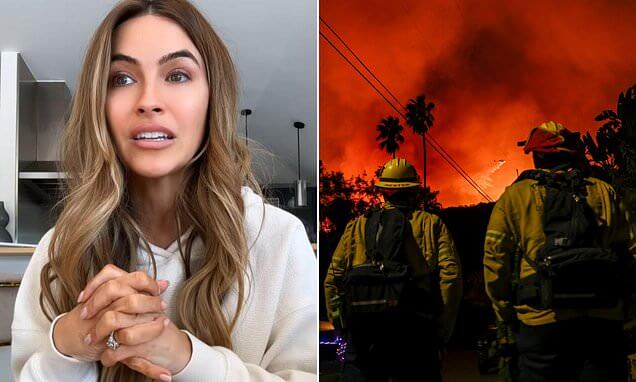World News
Chrishell Stause’s Harrowing Evacuation During the L.A. Wildfires: A Journey of Fear, Trauma, and Resilience
A Star Confronts the Flames: The Start of the Evacuation
Chrishell Stause, beloved star of Netflix’s Selling Sunset, recently shared a chilling account of her experience during the Los Angeles wildfires. When the Palisades Fire threatened her Hollywood Hills home, Stause found herself at the center of a life-threatening emergency. As evacuation orders swept through the region, the gravity of the situation became undeniable, forcing many residents, including Stause, to act swiftly.
The fires, fueled by dry weather and strong winds, posed a significant threat to homes, wildlife, and infrastructure. For Stause, the immediate danger was not just the encroaching flames but also the psychological impact of confronting such a perilous situation. The environment was tense, with the sky darkened by smoke and the air thick with ash. These conditions mirrored the chaos and urgency of the evacuation, turning an otherwise serene neighborhood into a scene of panic and fear.

Trauma Reawakened: A Childhood Memory Resurfaces
As the wildfires closed in, Stause found herself immobilized by fear—a response deeply tied to a traumatic event from her childhood. At the age of 12, she witnessed her family’s home consumed by flames, an event that left a lasting impression. While she had largely moved past the memory, the evacuation orders triggered an emotional flashback, leaving her “frozen in fear.”
This reaction is a common response to trauma, known as the “freeze” response, where individuals feel paralyzed and unable to take decisive action during moments of high stress. For Stause, the vivid recollection of her childhood loss overwhelmed her ability to respond to the immediate threat. The emotional weight of this moment underscored how deeply trauma can linger, sometimes lying dormant until reawakened by similar circumstances.
A Partner’s Role in Crisis: Support Amid Chaos
In the face of danger, Stause leaned heavily on her partner, Australian musician G Flip. While she struggled to overcome her paralysis, G Flip quickly took charge, demonstrating the importance of having a reliable support system during emergencies. They acted decisively, gathering essential belongings and organizing their safe evacuation.
G Flip’s actions highlight the critical role that loved ones play in navigating crises, especially for individuals grappling with trauma. Stause later expressed deep gratitude for their support, acknowledging that without their quick thinking, the outcome could have been far more devastating. Their teamwork serves as a testament to the power of partnership and mutual care in overcoming life’s most challenging moments.

The Larger Impact of Los Angeles Wildfires
The Palisades Fire is just one example of the increasingly frequent and devastating wildfires plaguing California. Over the years, climate change, prolonged droughts, and urban expansion have intensified the frequency and severity of wildfires in the region. These disasters not only destroy homes and displace families but also take a significant toll on mental health, as illustrated by Stause’s experience.
Wildfires like the one Stause faced have a ripple effect, impacting entire communities and ecosystems. As residents grapple with the immediate challenges of evacuation and property loss, they must also contend with the long-term psychological effects, including anxiety and post-traumatic stress. Stause’s story brings a human face to these disasters, emphasizing the importance of preparedness, community support, and systemic solutions to mitigate future risks.
Lessons Learned: The Importance of Preparedness and Awareness
In the aftermath of her evacuation, Stause reflected on the importance of emergency preparedness and the lessons she learned from the experience. She emphasized the need for individuals and families to have a plan in place, including knowing evacuation routes, having a go-bag ready, and staying informed about local emergency updates.
Beyond practical measures, Stause’s story also highlights the need for emotional preparedness. Recognizing the potential for trauma responses and seeking mental health support can be just as crucial as physical safety during crises. By sharing her experience, Stause has not only shed light on the challenges of navigating natural disasters but has also inspired others to prioritize their mental well-being and preparedness.
From dragontrendtees


